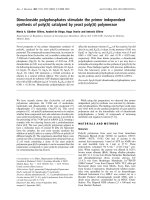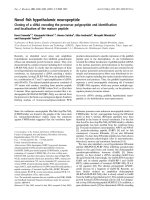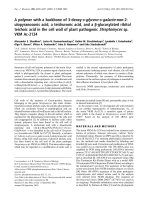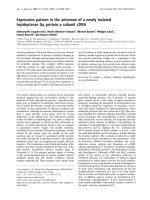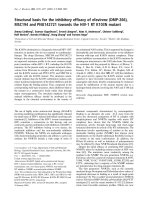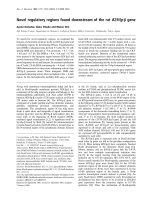Báo cáo Y học: Ascidian arrestin (Ci-arr), the origin of the visual and nonvisual arrestins of vertebrate pdf
Bạn đang xem bản rút gọn của tài liệu. Xem và tải ngay bản đầy đủ của tài liệu tại đây (643.5 KB, 7 trang )
PRIORITY PAPER
Ascidian arrestin (Ci-arr), the origin of the visual and nonvisual
arrestins of vertebrate
Masashi Nakagawa
1
, Hidefumi Orii
1
, Norihiro Yoshida
2
, Eri Jojima
3
, Takeo Horie
1
, Reiko Yoshida
1
,
Tatsuya Haga
3
and Motoyuki Tsuda
1
1
Department of Life Science, Graduate School of Science, Himeji Institute of Technology, Kamigori, Akoh-Gun, Hyogo, Japan;
2
Department of Neurochemistry, Faculty of Medicine, The University of Tokyo, Bunkyo-ku, Japan;
3
Institute for Biomolecular
Science, Faculty of Science, Gakushuin University, Toshima-ku, Tokyo, Japan
Arrestin is one of the key proteins for the termination of G
protein signaling. Activated G protein-coupled receptors
(GPCRs) are specifically phosphorylated by G protein-
coupled receptor kinases (GRKs) and then bind to arrestins
to preclude the receptor/G protein interaction, resulting in
quenching of the following signal transduction. Vertebrates
possess two types of arrestin; visual arrestin expressed
exclusively in photoreceptor cells in retinae and pineal
organs, and b-arrestin, which is expressed ubiquitously.
Unlike visual arrestin, b-arrestin contains the clathrin-
binding domain at the C-terminus, responsible for the
agonist-induced internalization of GPCRs. Here, we isolated
a novel arrestin gene (Ci-arr) from the primitive chordate,
the ascidian Ciona intestinalis larvae. The deduced amino
acid sequence suggests that Ci-Arr be closely related to
vertebrate arrestins. Interestingly, this arrestin has the
feature of both visual and b-arrestin. Whereas the expression
of Ci-arr was restricted to the photoreceptors in the larvae
similarly to visual arrestin, the gene product, containing the
clathrin-binding domain, promoted the GPCR internal-
ization in HEK293tsA201 cells similarly to b-arrestin. The
phylogenetic tree shows that Ci-Arr is branched from a
common root of visual and b-arrestins. Southern analysis
suggests that the Ciona genome contains only one gene for
the arrestin family. These results suggest that the visual and
b-arrestin genes were generated by the duplication of the
prototypical arrestin gene like Ci-arr in the early evolution of
vertebrates.
Keywords: arrestin; Ascidian; photoreceptors; internali-
zation.
G protein-coupled receptors (GPCRs) transduce a wide
variety of external stimuli including light, odors, hormones,
and neurotransmitters. Upon stimulation by these extra-
celluar signals, GPCRs promote the activation of heterotri-
meric G proteins by catalyzing the exchange of GDP for
GTP on the G protein a-subunit, followed by initiation of
the intracelluar signal transduction cascade. The active form
of GPCR must be inactivated within a proper time range for
cells to adapt to the changing environment. A two-step
process is involved in the inactivation mechanism. First the
activated GPCR is specifically phosphorylated by G
protein-coupled receptor kinase (GRK). Subsequently, a
soluble regulatory protein, arrestin, binds with high affinity
to the phosphorylated receptor to sterically inhibit the
interaction of the receptor with G protein, resulting in the
shutting-down of the downstream signaling [1–4].
Vertebrate arrestins can be divided into two classes; visual
arrestins and nonvisual, b-arrestins. Visual arrestins are
composed of rod- and cone-arrestins, both of which are
expressed exclusively in photoreceptor cells in the retina and
pineal organs and are thought to play a role in the
regulation of photo-signal transduction. Alternatively,
b-arrestins, which can be subdivided into b-arrestin1 and
b-arrestin2, are expressed ubiquitously and regulate various
GPCRs [4,5].
Some agonist-activated GPCRs are translocated from the
cell surface membrane to intracellular compartments. This
phenomenon is referred to as internalization or sequestra-
tion. b-Arrestin, but not the visual arrestins, plays a central
role in this internalization. b-Arrestin bound to the phos-
phorylated receptor recruits other key proteins, clathrin and
the AP2 complex, via distinct binding sites which are
conserved in the C-terminus of b-arrestin, leading to
endocytosis of the GPCRs [6–10]. Recent evidence showed
that b-arrestin is also involved in the switching from the
classical G protein mediated signaling to a different
signaling pathway, involving the MAPK cascades, where
b-arrestin functions both as an adaptor and a scaffold
[11–13].
Ascidians, sea squirts, belong to the phylum Protochor-
data, which is thought to be a prototype of the vertebrate
group. Unlike the sessile adult, the larva is tadpole shaped
Correspondence to M. Nakagawa, Department of Life Science,
Graduate School of Science, Himeji Institute of Technology,
3-2-1 Koto, Kamigori, Akoh-Gun, Hyogo 678-1297, Japan.
Fax: +81 791 58 0197, Tel.: + 81 791 58 0195,
E-mail:
Abbreviations: GPCR, G protein-coupled receptor; b
2
-AR,
b
2
-adrenergic receptor.
Note: The nucleotide sequence reported in this paper has been
deposited in the DDBJ/EMBL/GenBank under the accession number
AB052668.
(Received 23 June 2002, revised 18 August 2002,
accepted 9 September 2002)
Eur. J. Biochem. 269, 5112–5118 (2002) Ó FEBS 2002 doi:10.1046/j.1432-1033.2002.03240.x
and possesses some of the features typical of a vertebrate,
including a dorsal tubular central nervous system and a
notochord underlying the caudal neural tube [14–16]. Thus,
ascidians are attractive animals for researchers who are
interested in the early processes of vertebrate evolution.
In this study, we isolated cDNA encoding arrestin (Ci-
arr) from the larvae of the ascidian Ciona intestinalis.The
deduced amino acid sequence suggests that Ci-arr is more
closely related to vertebrate arrestins than to other inver-
tebrate ones. Interestingly, this arrestin possesses character-
istics of both visual and b-arrestin; the gene is expressed only
in the photoreceptor of the ocellus, but promotes agonist-
induced internalization in the cell culture HEK293tsA201.
We will discuss the relationship between the diversity and
function of the arrestin family.
MATERIALS AND METHODS
Cloning and sequencing of Ci-arr cDNA
cDNA was synthesized from Ciona larvae mRNA with
First-strand cDNA Sythesis Kit (Amersham Pharmacia
Biotech). The cDNA was amplified by PCR using a set of
degenerate primers for the conserved region among various
arrestins: the forward primer (5¢-TG
AAGCTTYMGITAY
GGIMGIGARGA-3¢: underline is HindIII site) and reverse
primer (5¢-AGG
AGATCTTGIARCATIACISWRCAN
GG-3¢: underline is BglII site) corresponded to the amino
acid sequences FRYGRED and PCSVMLQ, respectively.
Finally, based on the nucleotide sequence of the PCR
products, specific primers were synthesized and used for
5¢-and3¢-RACE. Based on the sequence of 5¢-and3¢-
flanking region of ORF of Ci-arr (Ar-full-N (5¢-CTGT
G
CTCGAGTTTGTACTCTGTCTAAC-3¢: underline is
XhoI site) and Ar-full-C (5¢-ACA
GGATCCAACAT
TTTGTGTAATATTT-3¢: underline is BamHI site) was
synthesized. The cDNA library of Ciona larvae on kZAPII
(a generous gift from T. Iwasa (Muroran Institute of
Technology, Japan)) was amplified using them and cloned
into pBluescript SKII
+
using XhoIandBamHI sites. To
eliminate PCR errors, several cDNA clones covering the
coding region were isolated and sequenced on both strands.
To analyze the expression levels of two isoforms, semi-
quantitative RT-PCR was performed using a set of primers,
Ar-ImunoFw (5¢-GCAGATCTGGACCCAATCATAGG
TTC-3) and Ar-full-C.
Whole-mount
in situ
hybridization
A full-length Ci-arr cDNA was used as a template to
synthesize digoxigenin-labeled antisense RNA probe.
Whole-mount in situ hybridization was performed accord-
ing to the procedure described by S. Wada [17]. Signals were
detected by 1/8 of AP substrate tablet Red of Multi color
Detection Set (Boehringer Mannheim) solubilized in 1 mL
of Tris/Mg/NaCl buffer [100 m
M
Tris/HCl (pH 9.5),
50 m
M
MgCl
2
,100m
M
NaCl].
Sequence data source
Sequence data used in the present analyses were taken from
GenBank, EMBL, SWISS-PROT or NCBI databases, with
following accession numbers: human rod (P10523), cone
(P36575), b-arrestin1 (P49407), and b-arrestin2 (P32121);
bovine rod (P08168), b-arrestin1 (P17870), and b-arrestin2
(P32120); mouse rod (P20443), rat rod (P15887), b-arrestin1
(P29066), and b-arrestin2 (P29067); bullfrog rod arrestin
(X92399); leopard frog rod (X92398) and cone (X92400)
arrestins; clawed frog rod (U41623) and cone (L40463)
arrestins; rainbow trout red blood cell arrestin (P51466);
killifish rod1 (AB002554), rod2 (AB029392), and cone
(AB002555) arrestins; fruit fly arrestin1 (P15372) and
arrestin2 (P19107); bluebottle fly arrestin1 (X79072) and
arrestin2 (X79073); migratory locust arrestin (S57174);
horseshoe crab arrestin (U08883); fruit fly kurtz
(AF221066); planarian arrestin (Orii et al. unpublished);
nematode arrestin (P51485).
Southern blot hybridization
Three types of the probes, a full-length Ci-arr cDNA (F),
5¢-region probe (N, XhoI–PstI fragment) and 3¢region (C,
PstI–BamHI fragment) were labeled with [
32
P]dCTP using a
BcaBest labeling kit (Takara) and used as probes for
hybridization.
Total DNA was isolated from the ovary of a single adult
of Ciona according to the standard method. Ten micro-
grams of DNA were digested with PstIorSpeI, separated
on 0.8% agarose gel, transferred onto nylon membranes
(Hybond-N
+
, Amersham Pharmacia Biotech) and immo-
bilized by UV cross-linking. The membrane was incubated
in 6 · NaCl/Cit containing 0.5% SDS, 5 · Denhardt’s
solution and 100 lgÆmL
)1
salmon sperm DNA at 60 °C
for 1 h. The radioactive probe was added to the prehybridi-
zation solution and incubated at 60 °C for 24 h. The
membrane was washed twice with 2 · NaCl/Cit containing
0.1% SDS at 60 °C for 20 min. The size of DNA was
estimated using kDNA digested with HindIII (Gibco BRL)
as standards. After autoradiography, the membrane was
washed out three times with 0.1% SDS at 100 °Ctoremove
the probe and then was hybridized again with another probe.
b
2
-Adrenergic receptor sequestration assay
The cDNAs encoding Ci-Arr and the mutant (V55D),
constructed by the inverted amplification method [18], were
subcloned into XhoIandBamHI site of the expression
vector pEF-BOS. pEF-b
2
-AR was constructed by using
cDNA encoding b
2
-AR, generously provided by
R. J. Lefkowitz (Duke University Medical Center, Durham,
USA). HEK293tsA201 cells, generously provided by C. J.
van Koppen (Institute fur Pharmakologie Universitatskli-
nikum Essen, Germany) were grown on 60-mm plates as
described elsewhere [19] and transfected with 0.5 lgof
pEF-b
2
-AR, in addition to either 2 lg of pEF-Ci-arr, pEF-
Ci-arr(V55D), or pEF-BOS(control vector), by LipofectA-
MINE2000 (Gibco) according to the manufacturer’s
instructions. After 24 h transfection, cells were replated on
poly
L
-lysine-coated 24-well plates and allowed to reattach
and grow for further 24 h.
Then cells were incubated with 10 l
M
isoproterenol for
the indicated times (time course experiment) or with the
indicated concentrations of isoproterenol for 30 min (dose-
dependence experiment). After washing with ice-cold phos-
phate-buffered saline, cells were incubated with 12 n
M
[
3
H]CGP-12177 (NEN Life Science Products) in 25 m
M
Ó FEBS 2002 Origin of vertebrate visual and nonvisual arrestins (Eur. J. Biochem. 269) 5113
Hepes-buffered Dulbecco’s modified Eagle’s medium/F-12
medium with and without 40 l
M
alpranolol to measure
total and nonspecific binding, respectively. After incubation
at 4 °C for 3 h, cells were washed with ice-cold phosphate-
buffered saline, solubilized in 1% Triton X-100 and mixed
with scintillation cocktail and then the radioactivity was
measured. Untransfected HEK293 tsA201 does not express
detectable levels of b
2
-adrenergic receptors.
The expression of Ci-Arr and Ci-Arr (V55D) was
confirmed by Western blotting with anti-(Ci-Arr) Ig.
RESULTS
We isolated two distinct cDNAs encoding an arrestin from
larvae of the ascidian Ciona intestinalis. They were identical
except for the 3¢ region, where 59 bp was deleted in one
form. RT-PCR showed that the longer form was expressed
at levels 16 times higher than the shorter one in the larvae
(T. Horie, M. Nakgawa, H. Orii & M. Tsuda, unpublished
work). Hence, we refer to the longer form as Ci-arr and the
shorter one as the truncated form. Figure 1 shows the
deduced amino acid sequence of Ci-arr aligned with those of
other arrestins. Ci-Arr was similar to other arrestins except
for the C-terminal region with 50–55% identity to verteb-
rate visual arrestins and 63–65% identity to vertebrate
nonvisual b-arrestins. In contrast, it had significantly lower
identity to the arthropod arrestins. JGI Ciona genome
project database ( />na.htm) and our partial analysis of the genomic DNA
revealed that at least 12 introns interrupt the coding region
of Ci-arr. Among them, nine introns are same in their
positions as those of vertebrate visual and b-arrestin genes
(Fig. 1), supporting close relationship between Ci-Arr and
vertebrate arrestins.
Fig. 1. Comparison of the amino acid sequences of Ci-Arr with some types of arrestins. The alignment of the deduced amino acid sequence of Ci-arr
and the typical animal arrestins was performed using a
CLUSTALW
program [20]. Since the insertion sequence of C-terminus apparently disturbed the
sequence alignment in the C-terminal portion, we manually optimized it from 350 to the end of the sequence. Dashes indicate gaps introduced to
optimize the alignment. Asterisks and dots under the sequences represent the identical and similar amino acids in eight sequences. Open and solid
wedges indicate the position of introns in Ci-arr and human visual arrestin genes, respectively. The box indicates the clathrin binding domain [21,22]
which may be responsible for the receptor internalization. White letters indicate AP2 binding site in b-arrestins [23]. White and black arrows indicate
the splicing sites in Ci-arr and bovine rod arrestin, respectively [24,25].
5114 M. Nakagawa et al. (Eur. J. Biochem. 269) Ó FEBS 2002
Comparison of two types of cDNA and genomic DNA
revealed that splicing of intron 11 resulted in the shift of the
reading frame in the truncated form, in which Asn387 in
Ci-Arr was replaced with Lys followed by stop codon (Fig. 1
white arrowhead). Similar truncated form of arrestin, termed
p44, in which the last 35 amino acids are replaced by a single
Ala, was detected in bovine retinal rod cells [24,25] (Fig. 1
black arrowhead). Since p44 was present abundantly in the
outer segment of a rod photoreceptor cell and inhibited
the activity of phosphodiesterase much more effectively than
the full-length form, p44 is thought to be a key component in
phototransduction [24,26]. There is no report on such
alternative splicing in the C-terminus of b-arrestin.
In the C-terminus, b-arrestins contain a characteristic
domain (371–379 for bovine b-arrestin2; arrestin3), which
visual arrestins lack [27]. This domain is known as the
clathrin-binding domain, which is responsible for the
receptor internalization [9,27,28]. Recently, the specific
arginine residues (R394 and R396 for b-arrestin2) in
b-arrestin that mediate its binding to AP2 were identified
[23]. The presence of the clathrin-binding domain and AP2
binding site in Ci-Arr (Fig. 1) suggests that this arrestin also
has the ability to internalize the receptor like b-arrestins.
Thus, we investigated whether Ci-Arr can promote the
internalization of GPCR by using HEK293tsA201 cells
exogenously expressing b
2
-adrenergic receptor (b
2
-AR),
established as the internalization assay system. Upon the
exposure of 10 l
M
isoproterenol, b
2
-AR agonist, the
numbers of the receptor at the cell surface with and without
overexpression of exogenous Ci-arr decreased by about 30
and 60% for 60 min, respectively (Fig. 2B). This indicates
that Ci-Arr significantly promoted the internalization of
b-AR. b-arrestin1 V53D (b-arrestin2 V54D) mutant is
known as a dominant negative mutant to suppress b
2
-AR
internalization [7], because it binds to the clathrin cages with
high affinity but is significantly impaired in its ability to
interact with b
2
-ARs [27]. We constructed the correspond-
ing mutant for Ci-Arr (V55D). This mutant, however,
showed that the extent of the internalization was almost the
same as that of the control (Fig. 2B) in spite of the same
levels of the expression (Fig. 2A). This result will be
discussed later. The isoproterenol concentration dependence
also showed that Ci-Arr induced about twofold sequestra-
tion of the receptors compared with control and V55D
(Fig. 2C). These results indicated that Ci-Arr was able to
promote the agonist-induced receptor internalization. It
should be noted that Ci-Arr promoted the internalization of
not only b
2
-AR, but also m2- and m4- muscarinic receptors
(data not shown).
The internalization of b
2
-ARs has been reported to be
unaffected by coexpression of b-arrestin1 but significantly
attenuated by coexpression of b-arrestin1 (V53D) [7,28]. We
confirmed these observations by experiments carried out in
parallel with the experiments on Ci-Arr (data not shown).
These results indicate that the Ci-Arr (V55D) does not
function in a dominant negative manner for endogenous
b-arrestin or related proteins, and that Ci-Arr enhances the
internalization of b
2
-ARs by the mechanism independent of
the function of endogenous b-arrestin or related proteins.
To know the expression pattern of Ci-arr gene in the
larva, we performed whole-mount in situ hybridization
using the digoxigenin-labeled riboprobe (Fig. 3). The signal
was observable in the photoreceptor cells on the right side of
the pigment cup of ocellus. No expression of Ci-arr gene
was detected in any other regions of the larva. The
expression pattern was identical to that of the opsin gene
Ci-opsin1 [29]. Furthermore, this result was confirmed by
immunohistochemical staining using the anti-(Ci-Arr) Ig
(T. Horie, M. Nakgawa, H. Orii & M. Tsuda, unpublished
work). As far as the expression sites, Ci-Arr can be regarded
as visual arrestin in the ascidian larvae.
Thus, Ci-Arr has both features of visual arrestins (the
exclusive expression in photoreceptors) and b-arrestins (the
function of promoting the receptor internalization). To
examine the evolutionary relationship among triploblastica
Fig. 2. Effects of wild-type and V55D mutant Ci-Arr on sequestration of
b
2
-adrenergic receptor in HEK293 tsA201 cells. (A) Detection of Ci-Arr
in HEK293 tsA201 cells transfected with pEF-BOS (control), pEF-
Ci-arr (WT), or pEF-Ci-arr (V55D) by immunoblotting using the
anti-(Ci-Arr) Ig. (B and C) HEK293 tsA201 cells transfected with pEF-
b
2
-AR together with WT, V55D, or control vector were incubated at
37 °C in the absence and presence of 10 l
M
isoproterenol for the
indicated period (B) or with the indicated concentrations of isopro-
terenol for 30 min (C). Data are the mean ± SE from triplicate
experiments.
Ó FEBS 2002 Origin of vertebrate visual and nonvisual arrestins (Eur. J. Biochem. 269) 5115
arrestin family, we constructed a molecular phylogenetic
tree. This tree demonstrates that triploblastica arrestins can
be classified into two major classes: vertebrate and protos-
tome arrestins (Fig. 4). Vertebrate arrestins are subdivided
into two groups, visual arrestins and b-arrestins. The tree
showed that Ci-Arr was more closely related to the
vertebrate arrestins than to protostome arrestins and that
it was branched from a common root of the vertebrate
visual and b-arrestins. This result allows us to propose a
hypothesis that Ci-Arr is the prototype of vertebrate arrestin
and that in the evolutionary process to vertebrates the
duplication of the prototype resulted in two different types
of arrestins, visual and b-arrestins. If so, Ciona must have
only one gene for arrestin.
Fig. 5. Genomic Southern blot analysis. (A) The probes used for
hybridization were schematically drawn under Ci-arr cDNA. It should
be noted that there is no SpeIsiteinCi-arr cDNA. (B) Genomic DNA
extracted from an individual adult of Ciona was digested with SpeIor
PstI. Each lane was loaded with a digest of 10 lg DNA. The same blot
was hybridized repeatedly with a full length probe (F), 5¢-region probe
(N) or 3¢-region probe (C) of Ci-arr cDNA in the low stringency
condition (6 · NaCl/Cit, 60 °C).
Fig. 4. Phylogenetic tree of arrestin family. The molecular phylo-
genetic tree was constructed by the neighbor-joining method [30] based
on the amino acid sequences of various arrestins using
CLUSTALW
program [20]. Bar indicates 10% replacement of amino acid per site.
Numbers at nodes are percentage of 1000 bootstrap replicates that
support the branches.
Fig. 3. Localization of Ci-arr mRNA in Ciona intestinalis larva. Ci-arr
mRNA was detected by whole-mount in situ hybridization using a
digoxigenin-labeled riboprobe. Dorsal views of (A) the whole larva
(scale bar, 100 lm), (B) magnified trunk region (scale bar, 50 lm)
Ciona larva has two pigments in the brain vesicle: the anterior pigment
is otolith (OT), the putative gravity sense organ and the posterior
pigment is ocellus (OC). The expression of Ci-arr is restricted to the
photoreceptors in the right side of the OC.
5116 M. Nakagawa et al. (Eur. J. Biochem. 269) Ó FEBS 2002
To confirm this hypothesis, we performed Southern
analysis with the genomic DNA of a single adult using three
types of probes: F (the full length of Ci-arr), N (5¢ fragment
when the full-length was digested with PstI), and C
(3¢ fragment with PstI digestion) (Fig. 5A). The hybridiza-
tion condition was low enough stringency (6 · NaCl/Cit at
60 °C) to detect other arrestin genes, because Lohse et al.[2]
could isolate b-arrestin clone from bovine brain cDNA
library using full length cDNA of bovine rod arrestin at
higher stringency condition (0.5 · NaCl/Cit at 65 °C). In
SpeIorPstI digestion, a single band was detected using
probes N or C, whereas both corresponding bands were
detected using probe F (Fig. 5B). Since cDNA of Ci-arr
contains a single PstI site but no SpeI (Fig. 5A), this result
indicated that single SpeI site is in an intron. These results
suggest that Ciona genome contains only one gene for
arrestin family.
BLAST
search of Ci-arr against JGI Ciona
genome project database indicated that all of 18 hits of
genomic DNA fragments were almost identical to Ci-arr
and that there are no hits with some similarity except for
them. This result also supports the suggestion that Ciona
does not contain any arrestin genes other than Ci-arr.
DISCUSSION
Gene duplication is thought to have occurred two times in
the early process of vertebrate evolution [31]. This hypothesis
is in agreement with our present results; the first gene
duplication of the prototypical arrestin gene like Ci-arr might
result in the ancestral visual and b-arrestins, the second
duplication might result in cone and rod arrestins from the
former, and b-arrestin1 and b-arresin2 from the latter.
Recently, it was reported that Drosophila visual arrestin
(Arr2) was involved in the apoptosis of the photoreceptor
cells [32,33]. In the photoreceptors of mutant flies whose
retinae degrade in light dependent manner, Arr2 was tightly
bound to photoactivated and phosphorylated rhodopsin
and the complex was dynamin-dependently internalized to
induce the apoptotic cell death of the photoreceptors,
although Arr2 dose not contain the consensus sequence for
clathrin binding (Fig. 1). In contrast, vertebrate visual
arrestin does not have the ability to bind clathrin and cannot
induce receptor internalization [6,8]. Ci-Arr retaining this
function is apparently close from the viewpoint of the amino
acid sequence similarity and the position of the intron to the
vertebrate type of arrestin (Fig. 1). Therefore, it may be
presumed that the function was lost in vertebrate visual
arrestin during the evolution.
The branch length of the phylogenetic tree (Fig. 4)
suggested that the evolutionary rates of the amino acid
substitutions in vertebrate visual arrestins was higher than
those of vertebrate b-arrestins as already reported by
Hisatomi et al. [34]. This is consistent with an idea that
the evolutionary rates of the molecules strongly depend on
their tissues [35].
Visual arrestin has the high receptor specificity for
rhodopsin, whereas b-arrestin only modestly discriminates
among rhodopsin, m2 muscarinic acetylcholine receptor
and b
2
-AR [36]. Therefore, it is possible that visual arrestins
widely were diverged with the divergence of opsin genes.
Our sequestration assay demonstrated that Ci-Arr promo-
ted the internalization for b-receptor as well as m2 and m4
muscarinic receptors. This result suggests that Ci-Arr has
low specificity to these receptors. Such property of b-
arrestin might be originated from Ci-Arr. On the other
hand, the visual arrestin may have been evolved to get high
specificity for the visual pigments, which is concomitant
with loss of the clathrin-binding domain.
ACNOWLEGEMENTS
We thank T. Kusakabe for useful discussion and the instruction in the
phylogenetic analysis. This work was supported in part by Grant-in-
Aid for Scientific Research (B) from Japanese Society for the
Promotion of Science to M. T.
REFERENCES
1. Wilden, U., Hall, S.W. & Kuhn, H. (1986) Phosphodiesterase
activation by photoexcited rhodopsin is quenched when rhodopsin
is phosphorylatrd and binds the intrinsic 48-kDa protein of rod
outer segments. Proc. Natl Acad. Sci. USA 83, 1174–1178.
2. Lohse, M.J., Benovic, J.L., Codina, J., Caron, M.G. & Lefkowitz,
R.J. (1990) b-Arrestin: a protein that regulates b-adrenergic
receptor function. Science 248, 1547–1550.
3. Ferguson, S.S., Barak, L.S., Zhang, J. & Caron, M.G. (1996)
G-protein-coupled receptor regulation: role of G-protein-coupled
receptor kinases and arrestins. Can J. Physiol. Pharmacol. 74,
1095–1110.
4. Krupnick, J.G. & Benovic, J.L. (1998) The role of receptor kinases
and arrestins in G protein-coupled receptor regulation. Annu. Rev.
Pharmacol. Toxicol. 38, 289–319.
5. Barak, L.S., Ferguson, S.S.G., Zhang, J. & Caron, M.G. (1997) A
b-arrestin green fluorescent protein biosensor for detecting G
protein-coupled receptor activation. J.Biol.Chem. 272, 27497–
27500.
6. Goodman,O.B.Jr,Krupnick,J.G.,Santini,F.,Gurevich,V.V.,
Penn, R.B., Gagnon, A.W., Keen, J.H. & Benovic, J.L. (1996)
b-Arrestin acts as a clathrin adaptor in endocytosis of the
b
2
-adrenergic receptor. Nature 383, 447–450.
7. Ferguson, S.S., Downey, W.E., Colapietro, A.M., Barak, L.S.,
Menard, L. & Caron, M.G. (1996) Role of beta-arrestin in medi-
ating agonist-promoted G protein-coupled receptor internaliza-
tion. Science 271, 363–366.
8. Oakley, R.H., Laporte, S.A., Holt, J.A., Caron, M.G. & Barak,
L.S. (2000) Differential affinities of visual arrestin, b-arrestin1, and
b-arrestin2 for G protein-coupled receptors delineate two major
classes of receptors. J. Biol. Chem. 275, 17201–17210.
9. Krupnick, J.G., Goodman, O.B. Jr, Keen, J.H. & Benovic, J.L.
(1997) Arrestin/clathrin interaction – localization of the clathrin
binding domain of nonvisual arrestins to the carboxyl terminus.
J.Biol.Chem. 272, 15011–15016.
10. Laporte, S.A., Oakley, R.H., Zhang, J., Holt, J.A., Ferguson, S.S.,
Caron, M.G. & Barak, L.S. (1999) The beta2-adrenergic receptor/
betaarrestin complex recruits the clathrin adaptor AP-2 during
endocytosis. Proc.NatlAcad.Sci.USA96, 3712–3717.
11. Lefkowitz, R.J. (1998) G protein-coupled receptors III. New roles
for receptor kinases and beta-arrestins in receptor signaling and
desensitization. J. Biol. Chem. 273, 18677–18680.
12. Pierce, K.L. & Lefkowitz, R.J. (2001) Classical and new roles of
beta-arrestins in the regulation of G-protein-coupled receptors.
Nat Rev. Neurosci. 2, 727–733.
13. Perry, S.J. & Lefkowitz, R.J. (2002) Arresting developments in
heptahelical receptor signaling and regulation. Trends Cell Biol.
12, 130–138.
14. Satoh, N. (1994) Developmental Biology of Ascidians.Cambridge
University Press, New York.
15. Satoh, N. & Jeffery, W.R. (1995) Chasing tails in ascidians:
developmental insights into the origin and evolution of chordates.
Trends Genet. 11, 354–359.
Ó FEBS 2002 Origin of vertebrate visual and nonvisual arrestins (Eur. J. Biochem. 269) 5117
16. Wada, H. & Satoh, N. (2001) Patterning the protochordate neural
tube. Curr. Opin. Neurobiol. 11, 16–21.
17. Wada, S., Katsuyama, Y., Yasugi, S. & Saiga, H. (1995) Spatially
and temporally regulated expression of the LIM class homeobox
gene Hrlim suggests multiple distinct functions in development of
the ascidian, Halocynthia roretzi. Mech. Dev. 51, 115–126.
18. Imai, Y., Matsushima, Y., Sugimura, T. & Terada, M. (1991) A
simple and rapid method for generating a deletion by PCR.
Nucleic Acids Res. 19, 2785.
19. Vogler, O., Nolte, B., Voss, M., Schmidt, M., Jakobs, K.H. & van
Koppen, C.J. (1999) Regulation of muscarinic acetylcholine
receptor sequestration and function by beta-arrestin. J. Biol.
Chem. 274, 12333–12338.
20. Thompson, J.D., Higgins, D.G. & Gibson, T.J. (1994) CLUSTAL
W: Improving the sensitivity of progressive multiple sequence
alignment through sequence weighting, position-specific gap
penalties and weight matrix choice. Nucleic Acids Res. 22, 4673–
4680.
21. Dell’Angelica, E.C., Klumperman, J., Stoorvogel, W. & Bonifa-
cino, J.S. (1998) Association of the AP-3 adaptor complex with
clathrin. Science 280, 431–434.
22. Shiina, T., Arai, K., Tanabe, S., Yoshida, N., Haga, T., Nagao, T.
& Kurose, H. (2001) Clathrin box in G protein-coupled receptor
kinase 2. J. Biol. Chem. 276, 33019–33026.
23. Laporte, S.A., Oakley, R.H., Holt, J.A., Barak, L.S. & Caron,
M.G. (2000) The interaction of b-arrestin with the AP-2 adaptor is
required for the clustering of b
2
-adrenergic receptor into clathrin-
coated pits. J.Biol.Chem. 275, 23120–23126.
24. Palczewski, K., Buczylko, J., Ohguro, H., Annan, R.S., Carr, S.A.,
Crabb, J.W., Kaplan, M.W., Johnson, R.S. & Walsh, K.A. (1994)
Characterization of a truncated form of arrestin isolated from
bovine rod outer segments. Protein Sci. 3, 314–324.
25. Smith, W.C., Milam, A.H., Dugger, D., Arendt, A., Hargrave,
P.A. & Palczewski, K. (1994) A splice variant of arrestin. Mole-
cular cloning and localization in bovine retina. J. Biol. Chem. 269,
15407–15410.
26. Langlois, G., Chen, C.K., Palczewski, K., Hurley, J.B. & Vuong,
T.M. (1996) Responses of the phototransduction cascade to dim
light. Proc. Natl Acad. Sci. USA 93, 4677–4682.
27. Krupnick, J.G., Santini, F., Gagnon, A.W., Keen, J.H. & Benovic,
J.L. (1997) Modulation of the arrestin–clathrin interaction in cells.
Characterization of b-arrestin dominant-negative mutants. J.Biol.
Chem. 272, 32507–32512.
28. Zhang, J., Ferguson, S.G., Barak, L.S., Menard, L. & Caron,
M.G. (1996) Dynamin and b-arrestin reveal distinct mechanisms
for G protein-coupled receptor internalization. J. Biol. Chem. 271,
18302–18305.
29. Kusakabe, T., Kusakabe, R., Kawakami, I., Satou, Y., Satoh, N.
& Tsuda, M. (2001) Ci-opsin1, a vertebrate-type opsin gene,
expressed in the larval ocellus of the ascidian Ciona intestinalis.
FEBS Lett. 506, 69–72.
30. Saitou, N. & Nei, M. (1987) The neighbor-joining method: a new
method for reconstructing phylogenetic trees. Mol. Biol. Evol. 4,
406–425.
31. Holland, P.W., Garcia-Fernandez, J., Williams, N.A. & Sidow, A.
(1994) Gene duplications and the origins of vertebrate develop-
ment. Dev Suppl. 125–133.
32. Alloway, P.G., Howard, L. & Dolph, P.J. (2000) The formation of
stable rhodopsin-arrestin complexes induces apoptosis and pho-
toreceptor cell degeneration. Neuron 28, 129–138.
33. Kiselev,A.,Socolich,M.,Vinos,J.,Hardy,R.W.,Zuker,C.S.&
Ranganathan, R. (2000) A molecular pathway for light-dependent
photoreceptor apoptosis in Drosophila. Neuron 28, 139–152.
34. Hisatomi, O., Imanishi, Y., Satoh, T. & Tokunaga, F. (1997)
Arrestins expressed in killifish photoreceptor cells. FEBS Lett.
411, 12–18.
35. Kuma, K., Iwabe, N. & Miyata, T. (1995) Functional con-
straints against variations on molecules from the tissue level:
slowly evolving brain-specific genes demonstrated by protein
kinase and immunoglobulin supergene families. Mol. Biol. Evol.
12, 123–130.
36. Gurevich, V.V., Dion, S.B., Onorato, J.J., Ptasienski, J., Kim,
C.M.,Sterne-Marr,R.,Hosey,M.M.&Benovic,J.L.(1995)
Arrestin interactions with G protein-coupled receptors. Direct
binding studies of wild type and mutant arrestins with rhodopsin,
b
2
-adrenergic, and m2 muscarinic cholinergic receptors. J.Biol.
Chem. 270, 720–731.
5118 M. Nakagawa et al. (Eur. J. Biochem. 269) Ó FEBS 2002

